

|
Home Updates Hydros Cars Engines Contacts Links Contact On The Wire |
Empty Spaces: Peter Rischer.
The 2004 European Championships at Basel was our first foray into the world of tethered car racing where we were the only couple from the UK and not a clue what was going on. Peter went out of his way to introduce himself, welcome us and explain what was happening, which made the whole experience much more enjoyable and meaningful. David Giles has very kindly provided us with an appreciation of Peter's life and career.
Yet another of the stalwarts of the Tether Car hobby was taken from us on September 20th 2023. He had been in declining health for some time before his death.
I first met Peter at Kapfenhardt, soon after becoming involved in tether car racing; I believe the year would have been 1978. As the only native English speaker racing at that time, he enjoyed talking to me in his slightly americanised English. I found him very helpful, extremely engaging and obviously a very talented engineer, with lots of original ideas which he was happy to share. He had had a very distinguished career in the Luftwaffe, flying the infamous F104 Starfighter. Among his many claims to fame was that he had attended the TOPGUN Instructional Course in America, where his flying skills were highly regarded.
Aside from his flying, Peter had for many years been bitten by the bug of tether car racing, having been active in the sport since 1958 and was in 1971 able to form a new club which was registered with the DMMC (Deutsche Modell Motor Club) and was within the military base (Boelcke Kaserne) at Kerpen in the north of Germany. The club was open to officers, ranks and civilians working on the base and had some 20 members. He was able to persuade the Luftwaffe to let them build a track where some 5 International Races, 4 Club Championships and 3 New Years races were held. Unfortunately, the track fell into disuse after he left the military.
Having had a long layoff from tether car racing due to work commitments and diversions into other hobbies, I renewed my friendship with Peter in 1998, and along with my partner June, it was suggested that we could break our journey to and from Kapfenhardt by staying at his home. We were always made very welcome, and it was sometimes difficult to leave to resume our journey, either to the track or onwards to home! This gave me the opportunity to spend many happy hours in his workshop, and the basement bar, talking tether cars and 2 – stroke racing engines. He was always experimenting with different engine configurations and some quite radical car designs, always ‘pushing the envelope’ and sometimes causing friction within the governing body. He built many experimental engines with various methods of supercharging, most of which were proof of concept and probably too bulky to be built into a car and remain within the maximum weight limit. He also experimented with induction systems, including drum valves, disc valves, and bell valves, also reed valves similar to those used on full sized racing engines, and seldom seen on miniature engines. He will be remembered in recent times I’m sure for his very successful 5cc cars and by the numbered batch of semi-scale Auto Union cars he produced with commercially available 4 – stroke engines.
His erudite conversation, engineering expertise and copious knowledge will be missed, not only by me, but by many tether car racers from around the world.
Peter Rischer gallery
A selection of the many and varied cars and engines that Peter produced over his long career, which illustrate much lateral thinking and delving into whether 'it could be done'. Photos from OTW and by courtesy of Karsten Rischer.
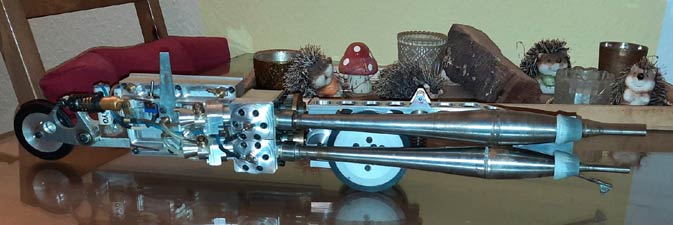
5cc reed valve twin car
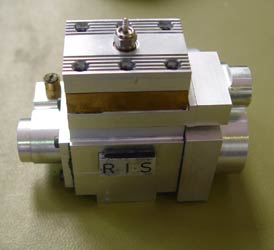 |
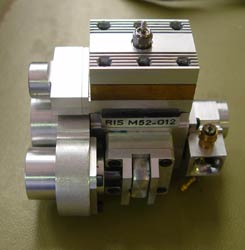 |
 |
| Two of Peter's supercharged motors | ||
 |
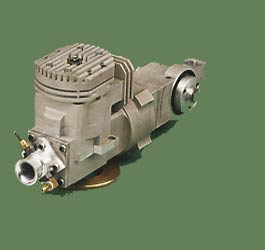 |
| Power Valve motor | 'All in one' unit |
 |
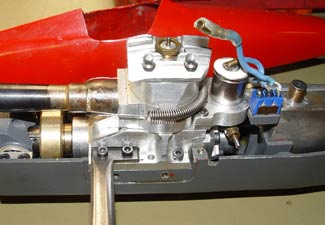 |
|
Unusual take on the tailskid ruling on this entirely home built car and engine |
|
|
|
|
Wankel rotary engined car built by Peter with his friend and neighbour Dr Fabritius |
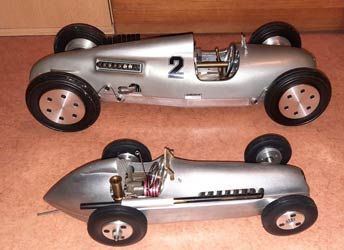 |
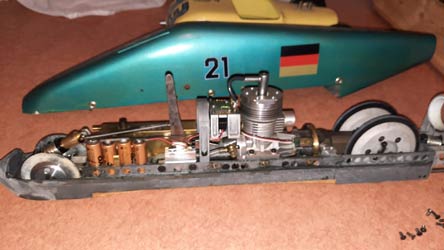 |
| Auto Union and an Oliver | Spark ignition motor in this car |
Empty Spaces: Edvard Stelling
|
|
For the best part of the last sixty years, the names of a number of individuals feature constantly in results lists, not only for their own accomplishments, which in themselves are impressive, but more for the supply of the cars, engines and parts that allow others to compete and be equally, or even more, successful, yet whilst still bearing the names of the original builders. Denneler, Kapusikov, Afanasiev and Picco spring immediately to mind, as does that of the late Edvard Stelling who had been building and supplying cars and engines for many years, along with untold thousands of aluminium and stainless steel tuned pipes, but it was not until relatively recently that he was able to use his own name. Left Edvard at Basel in 2013 |
|
His racing career spanned many
decades but for a long while his cars were named Lithuania,
engines LST and pipes, along with the 3b cars, Wilma, the
company believed to be producing them. He and his son would
regularly travel to meetings but come home without their cars
until the independence of the Baltic States when the Stelling
name would become more common. This allowed him to advertise a
range of products freely including these seen here, but just
look at the prices. |
|
As a competitor he was well to the fore in 1.5cc, 2.5cc and 5cc although his only major success was in 1998 when he won the Class 1 World Championship in Sydney also becoming vice European Champion the same year. The results from the period make interesting reading though as he used just two cars for several seasons, one of his own and the other, a Weiner with a Kapu motor.
We last saw Edvard at Basel for the 2023 European Championship where his car was laden down with items for sale, almost a one man swapmeet. Having raced for most of his career under the Lithuanian Flag there was speculation as to why he was now registered as a Polish competitor? His son revealed in the obituary that Edvard had actually been born in the part of Germany that is now Poland, so completing a seventy six year cycle.
The legacy of Edvard Stelling will be the number of entries at any competition that are still relying on the engines, cars and pipes that bear his name.
©copyrightOTW2025